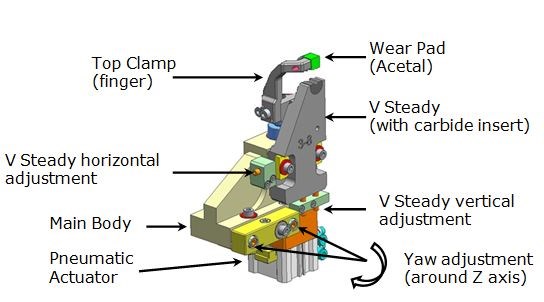Tool Grind Workholding System Limits Runout
Precision manufacturing requires minimal tool runout, but the amount of runout that is acceptable can be dependent on part tolerances and is often related to the size of the tool.
Precision manufacturing requires minimal tool runout, but the amount of runout that is acceptable can be dependent on part tolerances and is often related to the size of the tool. Limiting runout can only work in the shop’s favor.
MicroPlus, ANCA’s high accuracy workholding and tool support system, can significantly reduce tool runout during grinding, enabling the production of higher precision tools with no additional cycle time. The two-component system consistently limits radial and axial runout to less than 0.0001 inch (3 microns) for tools 2 inches (50 mm) from the face of the collet. Typical tool grinder runout is about 0.0002 inch. Suitable for both manual and automated tool loading, it can be used for the production grinding of 3- to 13-mm diameter tools. Designed for convenience, the system allows collets to be easily changed over with an unrestricted work envelope.
How it Works
The workholding and tool support system consists of two separate assemblies: the Flexi-Chuck assembly for workholding and the Overhead Top Clamp (OTC) assembly for tool guidance. The Flexi-Chuck clamps and rotates the tool to be ground, preventing any negative influences from affecting the guidance provided by the OTC, such as collet inaccuracy, inconsistent collet clamping and any misalignment caused by loading tools.
The clamping force is generated by disc spring stacks within the Flexi-Chuck assembly. This design provides sufficient force to clamp tools effectively. Flexi-Chuck does not use the conventional drawbar design and, therefore, is not affected by a drawbar system’s potential negative influence on tool runout.
In other systems, if the drawbar and tool are misaligned and not in a completely straight line, the drawbar tends to pull the tool at an off-center angle, causing runout. Also, rigid drawbar-mounted collets can over-constrain the workholding system, preventing the V-steady from controlling tool guidance.
The Flexi-Chuck, on the other hand, allows the tool and the internal components that lead to it to move independently of each other, absorbing any potential misalignment. With MicroPlus, tool guidance is achieved by the OTC assembly and the collet float of the Flexi-Chuck. The OTC guides the tool into an accurate workholding position without the Flexi-Chuck influencing tool alignment accuracy. The workholding part of the MicroPlus uses the flat-nose Schaublin W20 range of collets. Collet sizes range from 1/32 inch to 1/2 inch (1 mm to 13 mm).
Providing runout and alignment accuracy for the tool, the OTC consists of a V block that supports the tool to ensure axial and angular alignment. The OTC retains the tool in the precision V block with an overhead clamp. The clamp is a rigid metal finger with an acetal pad to prevent damage to the tool shank during grinding. The OTC is mounted on a rigid steady bed, and the tool is clamped and unclamped by a pneumatic actuator. The operator can adjust pneumatic clamping pressure of the finger to suit different tool types and diameters.
Software Setup
Automated setup assistance for MicroPlus is provided in ANCA’s ToolRoom software. This tool helps the operator to set the centerlines of the OTC assembly with the Flexi-Chuck, in both vertical and horizontal planes.
The MicroPlus is currently available for the MX7, GX7 and RX7 tool grinders as an option and can be retrofit to these machines.
Related Content
Studer S100 Grinding Machine For High-Precision, Flexible, Reliable Grinding
The machine is well suited for a wide range of internal, surface and external grinding applications, making it well suited for the entry-level market.
Read MoreGrindstar Replaces Turning With Efficient Grinding
PMTS 2023: The Grindstar machine uses a method that enables the entire workpiece contour to be ground in a single processing operation.
Read MoreStar Cutter Grinding Machines Improve Uptime, Throughput
Tru Tech grinding machines are designed to achieve high accuracy for high precision and micro components in numerous industries including medical, aerospace and electronics.
Read MoreCarbon Fiber Spindles Aim to Eliminate Grinding Variance
These spindles available on Tschudin CNC centerless grinders are designed to minimize the heat transfer factor while optimizing dimensional stability and material removal rate.
Read MoreRead Next
Medical Grinding Takes More Than a Machine
Medical grinding is attracting new players, partly because of opportunity, but also because it is possible to use the same equipment used to produce metalworking and woodworking tools.
Read MoreA Tooling Workshop Worth a Visit
Marubeni Citizen-Cincom’s tooling and accessory workshop offers a chance to learn more about ancillary devices that can boost machining efficiency and capability.
Read More5 Aspects of PMTS I Appreciate
The three-day edition of the 2025 Precision Machining Technology Show kicks off at the start of April. I’ll be there, and here are some reasons why.
Read More
















.jpg;maxWidth=300;quality=90)







